The Demystifying Religion in Mediation report was published in August as a collaboration between the Peacemakers Network and Al Amana International. Cassandra Lawrence shares her thoughts on the research process, its key findings and the lessons learned – thoughts that could be brought to mediation processes directly.
Heading picture: Cassandra Lawrence and a quote from the report.
Why was it critical to pursue this research?
The Peacemakers Network works in mediation and peace processes and one of the concrete activities the Network does is participate in training development and implementation. We wanted to pursue this research in order to get a comprehensive view on the accessibility of such trainings, the timely questions these trainings should pursue to answer, and how the impact of these trainings could be strengthened.
To add to this, the research had a broader purpose in supporting the current knowledge we have of religion in mediation. Even though there is a lot of information regarding the role of religion in conflict, there is not that much research on the question of religion as a tool for peacemaking. Information on religion, conflict and peace is still sparse, and the notion that religion is something irrational or should be left behind in conflict resolution is strong. Yet, globally more than eight-in-ten people identify with a religious group. In order to build sustainable peace and legitimate peace processes, religion cannot be sidelined.

Why is it so difficult to break the idea of an irrational, dangerous religion?
There is no simple answer to this question, but one thing to note is the current skillset received by diplomats and conflict resolution professionals. Most foreign policy and mediation professionals receive trainings in departments and countries where religion and state are far removed from each other. Or at least it is presented this way. In such approaches, the cultural context of the given conflict country or region is not addressed or if it is addressed they are addressed as a problem. Aggravating this problem is the fact that the countries struggling with including religious world views in peacemaking are countries where experience with religion has become remote, strictly private, and isolated to news alerts.
The challenge is not just the lack of tools to address religious discourse or culture. The most noticeable lack is in understanding. The farther removed religion is from the realm the peace practitioners come from, the more stereotypical and rudimentary understanding people tend to have about religion. Religion loses it’s lived value as something that nuances and pervades daily life for many people. Yet, even our society here in the United States is framed through religion. For example, if you don’t know or understand Christian religious narratives, you will miss nuance and larger narratives being constructed by the early architects of the constitution.
What was one of the biggest lessons learned while pursuing the report?
When we talk about religion and religious peacemaking, in relation to peace and conflict, these discussions are often taking place in the international relations department – overshadowing the theological framework. Instead of having a religious community reflect, why the conflict is happening and how they could build peace, the reflection is done from an outsiders perspective looking in on religion. Of course, both approaches are necessary, but if we are talking about religion, we should have religious people in the room.
Another theme related to bridging the theories and practices of mediation with the religious realm was unearthing the way religious actors perceive themselves as impacting mediation. One practical example was the notion of time. As Christians we often talk of “God’s timing”, meaning that things happen when the time is right. There is what I can do as a human, and there is what God will do on God’s time. Thus, the human opportunity for transformation is being made, but transformation itself cannot be forced.
The last finding I would like to highlight is that, like it or not, no one comes empty handed to a mediation space. We all come from a position of power, and unless we acknowledge and address this position, it is very difficult to win the trust of the people. There is one anecdote from the research, that I remember clearly. A middle-aged, white, male practitioner said: “No matter how much I have worked in resolving conflict, when I walk into the room, the representations bound to my physical body always follow me. I cannot put them back. My image, what I look like, has an effect on how I am perceived, and I have to take this into consideration.” This is regardless of whatever agency he represents. The trust he has, is built through personal interactions not through credentials given to him by his profession.

A tip for a practitioner?
What I would love to see and hear more and more in trainings is the unheard voices from various communities. We don’t often hear from the participants in the peace process, who live with the results everyday. I would love to see a discussion between religious, anthropological, regional, international, and academic approaches. So, instead of having religious peacemakers sit in one room learning how to be better peacemakers and diplomats in another learning how to engage with religion, have everyone come to the same room to discuss how to solve the conflict together.
Cassandra Lawrence is a mediation professional working in the intersection of religion and diplomacy. Ms. Lawrence currently works with the Shoulder to Shoulder Campaign and is a Masters of Divinity student and Public Theology fellow at Wesley Seminary’s Institute for Community Engagement.
Read and download the Demystifying Religion in Mediation report here.
To have a look at other Network publications, visit: www.peacemakersnetwork.org/our-work/network-publications
Anna Tervhartiala
Communications Officer
5.12.2017
